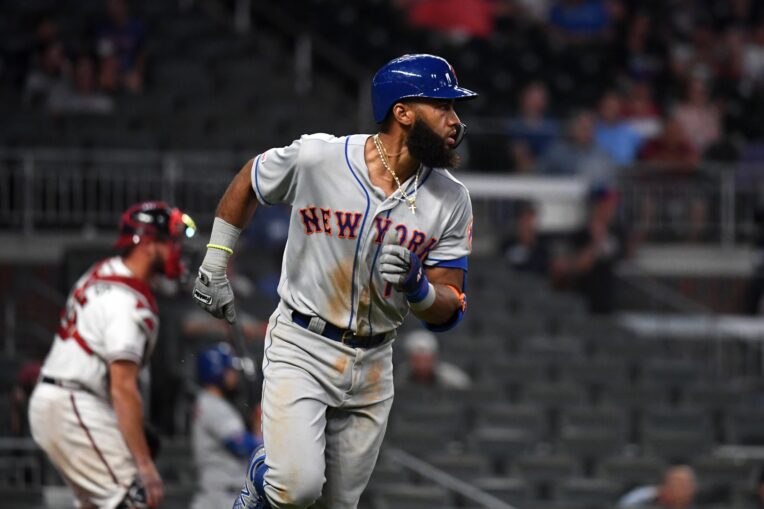
Although the New York Mets have a number of questions to answer once Spring Training starts in Port St. Lucie within the next few days, a solidified part of the roster includes the starting infield. One of the players who is part of it is 24-year-0ld shortstop, Amed Rosario.
The former top prospect has continued growing as a big leaguer since debuting late in 2017, and that growth is especially evident upon stepping into the batter’s box. His season-long wRC+ between 2017 and 2019 has gone from 75 to 85 to 100, which coincides with a similar increase in OPS (.665 to .676 to .755) and decrease in strikeout rate (28.8% to 20.1% to 18.9%).
When looking at Rosario’s overall value, the 2.7 fWAR he accumulated this past season easily surpassed what he had accumulated through his first season-plus (1.8). According to projections like Steamer (2.4) and ZiPS (2.3), the young shortstop is expected to once again be a solid contributor for New York. The one thing that has mostly eluded Rosario over his short big-league career to this point, though? A solid start. Since he didn’t make his MLB debut until August of 2017, we’ll just look at 2018 and 2019 for the sake of this exercise.
From March to July of his first full season with the Mets (in ’18), Rosario struggled to a 73 wRC+ through 353 plate appearances. His results were similar this past year if we simply look at his first-half numbers, which yielded an 88 wRC+ through 356 trips to the plate. Obviously, the saving grace in these two instances was that Rosario flipped a switch in the middle of each season and went on an offensive tear.
In 2018, he worked through his struggles at the plate from the first four months and finished both August and September with a monthly wRC+ greater than 100 for the first time as a big leaguer (it was 102 both times, to be exact). This past year, he posted a 114 wRC+ with a .319/.351/.453 triple slash in the second half upon coming back from the All-Star break.
Getting off to a sluggish start with the bat clearly hasn’t deterred Rosario from finishing strong and taking an overall step forward in his development each of the last two years. However, it’d be a huge mental boost to the young shortstop to actually hit the ground running once Opening Day rolls around next month (!) against the Washington Nationals. It’d especially be important in this case since Rosario’s batted-ball profile from the first and second half of 2019 show he may have experienced a hint of good fortune during his tear:

Either way, building upon a successful second half heading into the 2020 campaign is pretty much what we were hoping to see from him at the start of last season following those two slightly above-average months with the bat in August and September of 2018. Even with some struggles at the start of last year (both offensively and defensively), he was still worth nearly 3.0 wins above replacement.
If he can level out some of the production valleys and maximize the peaks a little more, who knows what he could be capable of accomplishing in 2020.
Rosario finally getting himself off to a fast start for the Mets will be helpful for the squad since the National League East is expected to be a close race once again. New York has displayed in recent years that racking up the victories in March and April doesn’t guarantee a thing as the season wears on, but it would certainly help Luis Rojas get himself acclimated while giving his club some wiggle room as the year progresses.
The 2015 season is a good reminder of that — the Mets got off to a great start by owning a 15-8 record upon waking up on May 1st. They essentially treaded water the three following months (13-15 in May, 12-15 in June, 13-12 in July) before some midseason acquisitions helped propel them to an NL pennant. The opportunity to trade for guys like Juan Uribe, Kelly Johnson, and Yoenis Cespedes wouldn’t have been possible without that strong first month of play.
So, it’s important for the Mets to come out of the gate strong and keep that momentum moving in the right direction. Having Rosario carry over his great second half from 2019 into the first half of 2020 would help that cause, as it’d lengthen the bottom part of the order.
This would also keep Rosario on the upward trend we’ve seen from him over the last couple years. He didn’t land in the big leagues with a bang like many other highly-touted prospects have recently, but if he keeps progressing at his current rate, he’s going to be a pretty darn good player once he hits his physical prime. The next step in that process is putting together an above-average performance from March to September (and hopefully, beyond).
What better time to do it than now, right?















